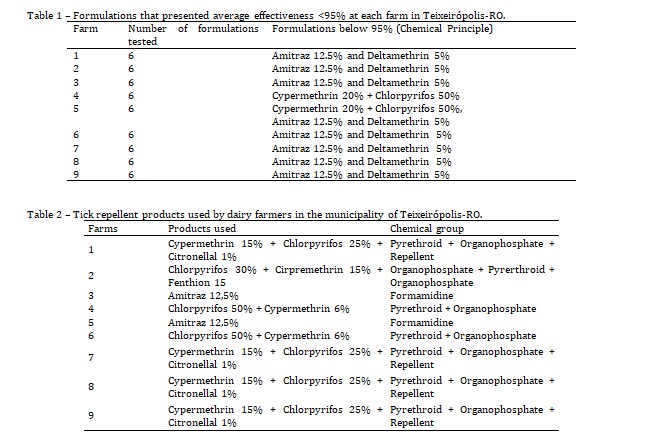Resistance of Rhipicephalus (Boophilus) microplus (Canestrini, 1888) to acaricides used in dairy cattle of Teixeirópolis, Rondônia, Brazil
DOI:
https://doi.org/10.21708/avb.2020.14.2.9123Resumo
Rhipicephalus microplus is one of the main ectoparasites of dairy cattle in Brazil, whose control is mainly based on the use of chemicals. However, the low variety of chemicals available, coupled with the indiscriminate use of these substances, has led to increased resistance for this tick. The objective of this study was to evaluate the resistance profile of the tick Rhipicephalus microplus to different acaricidal products used on dairy cows in Teixeirópolis-RO, using the Adult Immersion Test (TIA) or biocarrapaticidogram. Data was collected from nine farms by performing nine in vitro evaluation tests on engorged R. microplus females, using six different tick repelling treatments available on the market. Replicates of each treatment with 20 teleogins were performed for each treatment and a control group in distilled water was used for positive and negative controls. The efficiency amplitudes of each group and the average effectiveness of the acaricidal compounds were evaluated and compared by the Kruskal-Wallis test with a significance level of 95%. Statistical analyses were performed in the Action Stat statistical program. The tick repellents tested presented the following effectiveness averages: 100% (Chlorpyrifos at 50% + Cypermethrin at 6%); 99.99% (15% Cypermethrin + Chlorpyrifos at 25% + Citronellal at 1%); 77.63% (Cypermethrin at 20% + Chlorpyrifos at 50%); 100% (15% Cypermethrin + Chlorpyrifos at 25% + Piperonyl butoxide at 1%) -; 21.68% (Amitraz to 12.5%) -; 42.17% (Deltamethrin at 5%). Products with combinations of active ingredients were the most effective, and thus considered the best alternative for tick control.
Downloads

Downloads
Publicado
Edição
Seção
Licença
Autores que publicam na Acta Veterinaria Brasilica concordam com os seguintes termos: a) Autores mantém os direitos autorais e concedem à revista o direito de primeira publicação, com o trabalho simultaneamente licenciado sob a Licença Creative Commons Attribution que permite o compartilhamento do trabalho com reconhecimento da autoria e publicação inicial nesta revista. b) Autores têm autorização para assumir contratos adicionais separadamente, para distribuição não-exclusiva da versão do trabalho publicada nesta revista (ex.: publicar em repositório institucional ou como capítulo de livro), com reconhecimento de autoria e publicação inicial nesta revista. c) Autores têm permissão e são estimulados a publicar e distribuir seu trabalho online (ex.: em repositórios institucionais ou na sua página pessoal) a qualquer ponto antes ou durante o processo editorial, já que isso pode gerar alterações produtivas, bem como aumentar o impacto e a citação do trabalho publicado (Veja O Efeito do Acesso Livre).


 Esta obra está licenciada com uma Licença
Esta obra está licenciada com uma Licença 